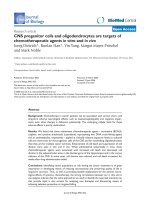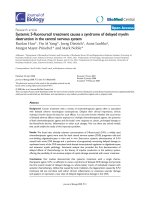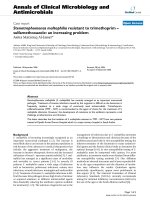Báo cáo sinh học: " Sequential GTG-RBA banding pattern in prometaphase chromosomes of cattle" doc
Bạn đang xem bản rút gọn của tài liệu. Xem và tải ngay bản đầy đủ của tài liệu tại đây (545.31 KB, 7 trang )
Original
article
Sequential
GTG-RBA
banding
pattern
in
prometaphase
chromosomes
of
cattle
(Bos
taurus
L)
D
Di
Berardino
MB
Lioi
2
D
Matassino
1
Universita,
degli
Studi
di
Napoli,
Dipartimento
di
Scienza
della
Produzione
Animale,
80055,
Portici,
Naples;
2
Universita,
degli
Studi
della
Basilicata,
Istituto
di
Produzione
Animale,
Facoltti
di
Agraria,
85100
Potenza,
Italy
(Received
14
November
1990;
accepted
17
April
1991)
Summary -
A
sequential
GTG-RBA
banding
procedure,
performed
for
the
first
time
on
the
same
prometaphase
chromosomes
of
cattle,
is
presented
with
the
aim
of
establishing
correlations
between
G
and
R
bands.
The
results
of
the
present
investigation
contributed
to
the
establishment
of
new
standard
GTG
and
RBA-banded
karyotypes
at
prometaphase
level,
useful
for
the
precise
identification
of
chromosomal
abnormalities,
comparative
cytogenetics
and
gene
mapping
in
the
species
Bos
taurus
L.
sequential
banding
/
GTG-bands
/
RBA-bands
/
standardization
/
cattle
Résumé -
Une
nouvelle
technique
de
mise
en
évidence
séquentielle
des
bandes
G
et
R
sur
les
chromosomes
prométaphasiques
du
bovin
(Bos
taurus
L).
Une
nouvelle
technique
de
mise
en
évidence
séquentielle
de
bandes
G
et
R
est
présentée
pour la
première
fois
sur
les
chromosomes
prométaphasiques
du
bovin
dans
le
but
d’établir
des
corrélations
entre
les
bandes
G
et
R.
Les
résultats
de
cette
étude
ont
contribué
à
l’établissement
de
nouveaux
caryotypes
standards
en
bandes
G
et
R
au
niveau
prométaphasique.
Cette
étude
est
utile
pour
l’identification
précise
des
anomalies
chromosomiques,
pour
les
études
de
cytogénétique
comparée
et
pour la
localisation
des
gènes
de
Bos
taurus.
bandes
séquentielles
/
bandes
G
/
bandes
R
/
standardisation
/
bovin
*
Correspondence
and
reprints
INTRODUCTION
The
Reading
conference
on
the
standardization
of
banded
karyotypes
of
domestic
animals
(Ford
et
al,
1980),
undoubtedly
one
of
the
most
important
steps
in
the
history
of
animal
cytogenetics,
provided
for
the
first
time
the
’standard’
G-banded
karyotype
of
cattle
(Bos
taurus
L)
as
well
as
that
of
other
domestic
species.
Despite
its
excellent
quality,
the
bovine
standard
G-banded
karyotype
soon
revealed
some
limitations
for
chromosome
identification,
due
mainly
to
the
degree
of
contraction
of
the
chromosomes
used
for
the
standard
and,
secondarily,
to
an
intrinsic
feature
of
bovine
chromosomes,
common
to
all
the
Bovidae,
ie
G-negative
centromeres
and
telomeres.
These
problems
have
made
it
necessary
to
improve
the
Reading
standard
by
using
less
contracted
chromosomes
and
to
adopt
alternative
banding
techniques
such
as
RBA
and
QFQ
for
standardization
of
new
karyotypes
which
could
be
used
more
widely
by
the
scientific
community.
This
paper
reports
the
results
of
the
sequential
GTG-RBA
banding
technique
performed
for
the
first
time
on
the
same
prometaphase
chromosomes
of
cattle
in
order
to
establish
correlation
between
the
GTG
and
the
RBA
bands.
These
results
provided
an
important
part
of
the
material
used
for
the
discussions
at
the
2nd
International
Conference
for
the
Standardization
of
Banded
Karyotypes
in
Domestic
Animals,
held
at
Jouy-en-Josas
(France)
the
22-26th
of
May,
1989
(ISCNDA,
1989).
MATERIAL
AND
METHODS
Peripheral
blood,
drawn
from
the
jugular
vein
of
5
young
bulls
of
the
Italian
Friesian
breed,
was
cultured
at
37.5°
C
for
72
h
in
RPMI
1640
medium
(Flow,
Dutch
modification)
supplemented
with
10%
fetal
calf
serum
(Gibco),
0.1%
L-
glutamine
and
0.1
ml
of
pokeweed
mitogen
(Gibco).
6.5
h
before
harvesting
cells,
5’-bromodeoxy-uridine
(BUdR,
Sigma)
at
a
final
concentration
of
20
pg/ml
and
5.5
h
later
colcemid
solution
(Gibco,
final
concentration
of
0.03
pg /ml)
were
added.
In
order
to
facilitate
the
spreading
of
the
prometaphase
chromosomes
the
cell
suspension
was
subjected
to
a
stronger
hypotonic
shock
than
usual
(0.05
M
KCI)
at
37.5°
C
for
20
min
and
fixed
with
methanol-acetic
acid
solution
(3:1)
for
1
h,
centrifuged,
fixed
again
and
left
overnight
in
the
refrigerator.
Air-dried
slides
were
prepared.
Sequential
GTG-RBA
banding
procedure
The
air-dried
slides,
3-5-d
old,
were
treated
for
GTG
banding
according
to
Lin
et
al
(1977);
soon
after
the
Giemsa
staining,
the
slides
were
flooded
with
phosphate
buffer
(pH
=
7),
covered
with
a
coverslip
and
examined
with
a
Leitz
Dialux
under
bright
field
optics.
The
best
G-banded
prometaphase
spreads
were
selected
and
photographed
with
a
Kodak
microfilm
1454.
After
microphotography,
the
coverslip
was
removed,
the
slide
was
destained
gently
in
30%
ethanol
for
10
min,
washed
in
distilled
water,
air-dried
and
stained
with
an
acridine
orange
solution
(0.2%
in
phosphate
buffer)
for
15
min,
washed
again
in
tap
water,
mounted
in
the
same
buffer
and
sealed
with
paraffin
(Di
Berardino
et
al,
1979).
The
prometaphase
spreads
previously
examined
for
GTG
banding
were
relocated
and
photographed
again
for
RBA
banding
with
the
same
Kodak
microfilm
1454.
Kodabrome
F2M
and
F3M
papers
were
used
for
printing
GTG
and
RBA
banded
prometaphase
spreads,
respectively.
RESULTS
Figure
1
(A
and
B)
shows,
respectively,
a
GTG-banded
prometaphase
spread
of
cattle
(2n
=
60,
XY)
and
the
same
spread
sequentially
stained
for
RBA-banding.
In
order
to
verify
the
correspondence
between
the
Reading
standard
and
the
prometaphase
G-banding
pattern,
individual
chromosomes
from
figure
1A
were
arranged,
side
by
side,
with
the
G-banded
chromosomes
of
the
Reading
standard,
as
shown
in
figure
2.
From
this
figure
it
is
possible
to
verify
the
great
advantage
and
usefulness
of
using
prometaphase
instead
of
metaphase
chromosomes,
especially
for
the
identification
of
the
smallest
autosomes
ranking
from
pairs
No
21-29.
All
the
G-banded
prometaphase
chromosomes
fit
very
well
to
the
Reading
standard,
thus
providing
more
information
for
a
definite
characterization
and
identification
of
in-
dividual
chromosomes
of
the
species.
However,
because
of
chromosome
contraction
of
the
G-banded
cattle
chromosomes
reported
by
the
Reading
standard,
it
is
quite
difficult
to
distinguish
among
the
chromosomes
Nos
25,
27
and
29;
hence,
it
is
not
fully
evident
that
the
actual
prometaphase
pairs
correspond
to
the
ones
of
the
Reading
standard.
In
order
to
examine
in
detail
the
correlation
between
the
GTG
and
the
RBA
banding
pattern
of
individual
prometaphase
chromosomes
of
cattle,
figure
3
(A,
B
and
C)
was
prepared
in
which
the
GTG-banded
prometaphase
chromosomes
from
figure
lA
(b
and
d)
are
compared
with
the
sequentially
stained
RBA-banded
chromosomes
(a
and
e)
and
with
the
’direct’
RBA
banded
chromosomes
(c).
From
this
figure
it
is
possible
to
verify
the
correct
correspondence
between
G
and
R
bands
in
almost
all
of
the
chromosomes,
including
the X
and
Y
sex
chromosomes.
DISCUSSION
The
sequential
GTG-RBA
banding
procedure,
performed
for
the
first
time
on
chromosome
of
cattle,
is
suitable
for
a
specific
characterization
of
individual
chromosomes
of
this
species.
Previous
contributions
on
the
RBA
banding
pattern
in
cattle
chromosomes
(Popescu,
1975;
Gustavsson
and
Hagelthorn,
1976;
De
Giovanni
et
al,
1979; 1988;
Di
Berardino
et
al,
1979,
1983,
1985a,
1985b;
Di
Berardino
and
Iannuzzi,
1982)
reported
karyotypes
which
were
based,
as
far
as
possible,
on
the
Reading
G-banded
standard
karyotype,
but
a
direct
correlation
between
G
and
R
bands
has
not
so
far
been
reported.
Recently,
a
G-
and
R-banding
comparison
of
cattle
prometaphase
chromosomes
arranged
according
to
the
Reading
system
has
been
reported
(Iannuzzi,
1990)
but
without
use
of
a
sequential
G-R
banding
procedure.
The
present
investigation
was
carried
out
in
order
to
make
correlations
between
G
and
R
bands
on
the
same
chromosome
preparation,
thus
providing
the
necessary
information
for
the
definition
of
new
standard
GTG
and
RBA
banded
karyotypes
for
the
species
Bos
taurus
L.
the
sequential
procedure
reported
here,
the
BUdR
incorporation
necessary
to
achieve
the
RBA
banding
did
not
seem
to
affect
the
G-banding
pattern.
Also
the
trypsin
treatment
used
for
GTG-banding
did
not
produce
significant
effects
on
the
quality
of
the
RBA-banding
pattern
in
almost
all
of
the
chromosomes.
Therefore,
this
procedure
could
also
be
used
for
the
standardization
of
GTG
and
RBA-banded
k
c1
xyotypes
of
other
domestic
species
for
which
extensive
cytogenetic
material
is
already
available.
Other
ways
using
G-
and
R-banded
marker
chromosomes,
such
as
centric
fusions,
translocations
and
nucleolus
organizer
chromosomes
of
Bovidae,
as
well
as
the
biarmed
chromosomes
of
related
species,
could
provide
additional
information
for
a.
definitive
characterization
of
the
banding
pattern
of
individual
chromosomes
of
the
species
Bos
taurus
L.
The
results
of
the
present
paper
contributed
to
the
definition
of
the
’standard’
GTG
and
RB A-banded
karyotypes
and
idiograms
of
cattle
at
the
prometaphase
level
(ISCNDA,
1989)
useful
for
precise
description
and
identification
of
numerical
as
well
as
structural
chromosomal
aberrations,
comparative
cytogenetics
and
gene
mapping.
Financial
support
for
this
study
was
obtained
from
the
National
Research
Council
(CNR)
of
Rome,
Italy.
REFERENCES
De
Giovanni
A,
Succi
G,
IVIolteni
L,
Castiglioni
M
(1979)
A
new
autosomal
translocation
in
Alpine
grey
cattle.
Ann
Genet
Sel
Anini
11,
115-120
De
Giovanni
A,
Molteni
L,
Succi
G,
Galiani
C,
Boscher
J,
Popescu
P
(1988)
A
new
type
of
Robertsonian
translocation
in
cattle.
In :
8th
Eur
Coll
Cytog
Dom
Anim,
Bristol
19-22
July
1988,
53-59
Di
Berardino
D,
Iannuzzi
L,
Ferrara
L,
Matassino
D
(1979)
A
new
case
of
Robertsonian
translocation
in
cattle.
J
Hered
70,
436
Di
Berardino
D,
Iannuzzi
L
(1982)
Detailed
description
of
R-banded
bovine
chromosomes.
J
Hered
73, 434-438
Di
Berardino
D,
Iannuzzi
L,
Di
Nleo
GP
(1983)
Localization
of BrdU
induced
break
sites
in
bovine
chromosomes.
Caryologia
36,
285-292
Di
Berardino
D,
Lioi
MB,
Iannuzzi
L
(1985a)
Identification
of nucleolus
organizer
chromosomes
in
cattle
(Bos
taurus
L)
by
sequential
silver
staining
+
RBA-banding.
Caryologia
38,
95-102
Di
Berardino
D,
Iannuzzi
L,
Lioi
MB
(1985b).
The
high
resolution
RBA
banding
pattern
in
bovine
chromosomes.
Cytogenet
Cell
Genet
39,
136-139.
Ford
CE,
Pollock
DL,
Gustavsson
I
(1980)
Proceedings
of
the
First
International
Conference
for
the
Standardization
of
Banded
Karyotypes
of
Domestic
Animals,
Reading,
1976.
Gustavsson
I,
Hagelthorn
M
(1976)
Staining
technique
for
definite
identification
of
individual
cattle
chromosome
in
routine
analysis.
J
Hered
67,
175-178
Iannuzzi
L
(1990)
An
improved
characterization
of
cattle
chromosomes
by
means
of
high
resolution
G-
and
R-band
comparison.
J
Hered
81,
80-83
ISCI!TDA
(1989)
International
System
for
Cytogenetic
Nomenclature
of Domestic
Animals
(Di
Berardino
D,
Hayes
H,
Fries
R,
Long
S,
eds),
Cytogenet
Cell
Genet
53,
G5-79
Lin
CC,
Newton
DR,
Church
RB
(1977)
Identification
and
nomenclature
for
G-
banded
bovine
chromosomes.
Can
J
Genet
Cytol 19,
271-282
Popescu
CP
(1975)
Essai
d’identification
des
chromosomes
bovins
(Bos
taurus
L)
a
l’aide
du
marquage
au
5-bromo-deoxy-uridine
(BrdU). 2’
Coll
Eur
de
Cytog6n6tique
des
Animaux
Domestiques.
Giessen,
59-64









